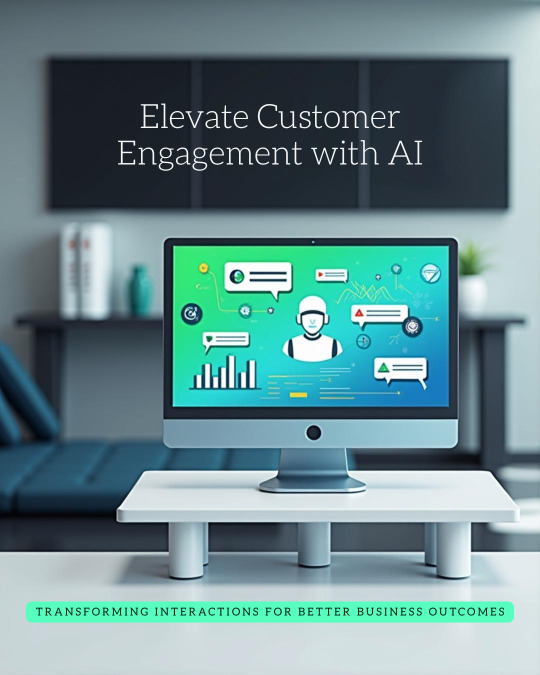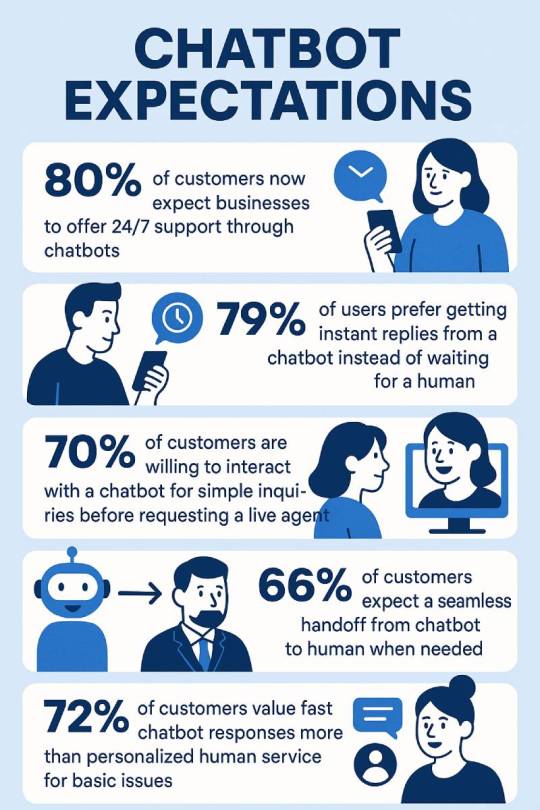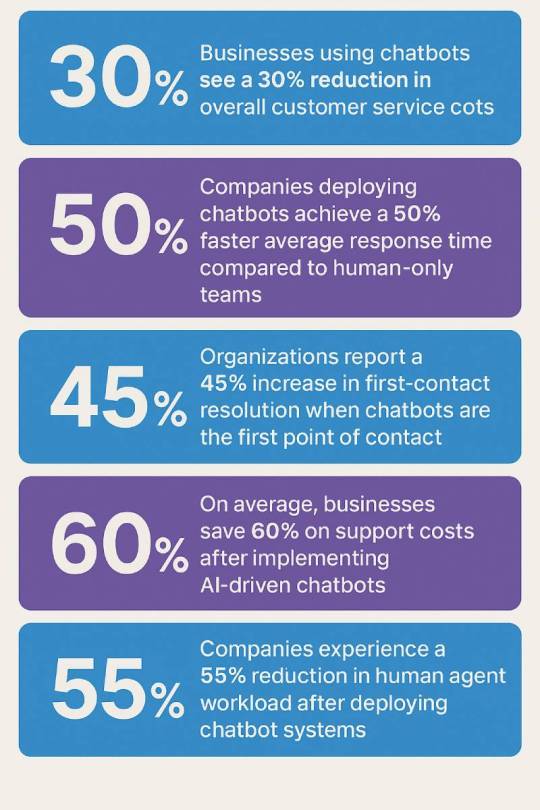#custom chatbot development services
Explore tagged Tumblr posts
Text
Custom Theme Development in UAE: Hire eCommerce developers in UAE
Looking to stand out in the crowded eCommerce landscape? With Custom Theme Development in UAE, your brand can deliver a unique, memorable shopping experience tailored to your audience. Our UAE-based eCommerce developers combine local market knowledge with global design trends to craft custom themes that not only look stunning but also drive conversions. From user-friendly navigation to mobile-first design and SEO best practices, we ensure your site is built for performance and profitability. Hire skilled eCommerce developers in the UAE and transform your vision into a fully customized online store that reflects your brand’s personality.
#chatbot development services#hire chatbot developers#chatbotdevelopment#chatbot development#chatbot#technology#chatbotservices#leading chatbot development company in uae#custom chatbot development services
0 notes
Text
Top Chatbot Development Company to Automate Your Customer Support Need smarter support without extra effort? Bitcot is a top chatbot development company that builds custom AI chatbots to handle your customer service 24/7. We help you automate responses, reduce wait times, and boost satisfaction—all while saving your team time and energy. Whether you’re just starting or scaling up, we make chatbot automation simple, powerful, and effective. Let’s build something smart together.
#ai chatbot development services#chatbot development services#chatbot development company#custom chatbot development services#chatbot development agency#chatbot integration services#chatbot consulting services
0 notes
Text
What Are the Benefits of Using Cloud Solutions Software?

Virtualization of computing devices to facilitate mobility and collaboration helped global corporations embrace novel workflows. Besides, the world realized the true worth of investing in a secure cloud ecosystem in 2020. Software testing and cloud-hosted cybersecurity measures prove why this technology goes beyond the “learn from home” and the “work from home” revolutions. This post will explore the benefits of using cloud solutions software in business.
What is Cloud Solutions Software?
Cloud solutions software has all its core files, including code libraries, audiovisual media assets, and “work in progress” project data hosted on remote servers. These facilities enable a flexible and scalable computing experience utilizing cutting-edge data management solutions to run complex programs.
However, corporations relying on legacy IT infrastructure must cautiously migrate to cloud solutions software. Otherwise, they risk losing precious data necessary for analytics, regulatory disclosures, and periodic audits. Once a brand successfully integrates a trusted cloud computing platform, it can unlock unique productivity advantages across team collaboration and data governance.
What Are the Top Benefits of Using Cloud Solutions Software?
1| Secure Storage as a Service (STaaS)
A local business has fewer data management needs than a global organization would require. Yet, storing critical files on-premises increases data loss risks due to fire hazards, theft, hardware-level tinkering, and physical or liquid damages. Thankfully, Storage-as-a-service (STaaS) is a recognized use case of cloud solutions software that overcomes the drawbacks of local data repositories.
Why does STaaS matter to enterprise data governance? Every brand wants to process data ensuring comprehensive cybersecurity and consumer privacy compliance. After all, non-compliance can translate to financial penalties, trade restrictions, increased regulatory oversight, and executive officers receiving imprisonment.
Consider the personally identifiable information (PII) that custom chatbot development services might use for client experience personalization. These tools and their client companies can disclose their objectives in their privacy policies.
Still, customers expect both to uphold a reputable data safety and anti-phishing standard. Cloud-powered STaaS allows all firms to fulfill these essential cybersecurity obligations.
2| Real-Time Team Collaboration
Gone are the days when one report requiring five signatures would travel from one desk to another for a week or longer. With the advent of cloud platforms and hybrid workplace environments, industries witness a growing trend toward real-time collaboration.
Today, multiple team members can create, comment on, modify, and approve each other’s contributions to a project file without time loss. Cloud solutions software specializing in leadership and human resource management will also empower managers to track how each team member uses the company’s resources.
Professionals might work in distinct departments, branch offices, or independent agencies. Yet, reporting and idea exchanges will happen seamlessly, thanks to the collaboration-friendly features of cloud platforms.
3| Ease of Backups and Migration
When a company has stored business-critical intelligence in multiple devices, transferring it to a newer IT ecosystem or consolidating it will immediately become a disaster.
After all, data management professionals will have to overcome the following obstacles.
They must compare databases to distinguish between outdated records and the latest ones.
Data managers must mitigate technical compatibility risks. So, they will devise dedicated protocols to handle legacy file systems and discontinued reporting formats.
Simultaneously, their top priority is reducing operational downtime as much as possible during data migration. Otherwise, productivity and capacity utilization will dip, adversely affecting the net profit margin.
Likewise, creating digital backups of analog or semi-structured data objects like scanned PDFs of handwritten documents is a liability. It complicates storage and categorization tasks. Nevertheless, today’s cloud solutions software can assist business leaders in resolving these issues. They often include one-click options to import and export databases in universally adapted formats.
Conclusion
An on-premises data ecosystem has become redundant due to the birth of competitively priced cloud computing facilities. While specific business intelligence might seem safer in local systems, the increased sophistication of cybercriminals’ tactics suggests otherwise.
Remember, navigating this era where each stakeholder must work toward decreasing electronic waste demands an environmentally responsible data management mindset. And integrating cloud solutions software is the most useful method of combating corporate e-waste risks.
You have learned how this technology benefits enterprises. All that remains is to select a competent data management partner with a solid project portfolio.
0 notes
Text

At Umano Logic, a renowned Advanced Technology Solutions Edmonton, we comprehend the importance of adopting the latest trend in advanced technologies to develop the most powerful and Smart applications.
For More information: https://www.umanologic.ca/advance-technology/
#Advanced Technology Solutions Edmonton#custom Chatbot Development Services#IoT Solutions in Edmonton#AI solutions provider in Edmonton#hire blockchain developer
0 notes
Text
#chatbot development agency#ai chatbot development company#custom chatbot development services#custom chatbot development#ai chatbot development services
0 notes
Text
AI Chatbot Development Services for Seamless Customer Support
Our AI-based chatbot development services are designed to provide businesses with an efficient
and scalable solution to improve customer service and streamline workflows. With advanced features such as 24/7 availability, multilingual support, and seamless integration with CRM, ERP, and other business systems, our chatbot platform ensures a smooth customer experience.
We offer highly customizable chatbots tailored to your brand’s voice, enabling businesses to manage high volumes of interactions, enhance user engagement, and boost sales. Our chatbots also feature in-depth analytics that provides valuable insights into user behavior, helping you continuously optimize your customer service efforts. Whether you’re a small and medium enterprise (SME) or a large business enterprise, our chatbot services can be adapted to meet your specific needs. With support for both audio and video calls, and integration with multiple platforms like AWS, Google Cloud, and Azure, our chatbots are the smart choice for businesses looking to improve customer satisfaction and drive revenue growth.
Contact Information
Email: [email protected]
Phone Numbers: +1 408 454 6110
Location: 410 E Santa Clara Street, Unit #1023, San Jose, CA 95113
#<Ai Chatbot solutions>#<Ai chatbot development>#<chatbot services>#<Ai chatbot app development>#<Customer service Automation>#<Chatbot integration>
2 notes
·
View notes
Text
From Chaos to Control: How AI Agents Are Rewriting the Rules of Productivity and Efficiency!!!

In a world increasingly defined by complexity, where teams are drowning in tasks, decisions are delayed, and data is overwhelming, a quiet revolution is reshaping the landscape of AI agents.
These intelligent, adaptive systems are no longer just futuristic concepts. They are now embedded across industries, transforming how we manage work, automate decisions, and enhance human capabilities. From startup founders to enterprise teams, everyone is looking for ways to reclaim control, and AI Agent Development Company is the answer.
The Evolution of Efficiency: Where Traditional Automation Fails
Traditional automation tools have long aimed to streamline operations. From basic scripts to robotic process automation (RPA), businesses have deployed countless solutions in search of productivity. Yet, most of these tools are rigid, rule-based, and ill-equipped to handle change.
Let’s face it: The modern business environment is unpredictable. Markets shift rapidly, customer needs evolve, and data streams in from every direction. What companies need today are not just automated systems, but intelligent agents that can adapt, learn, and evolve in real time.
Enter AI agents, smart, autonomous, and deeply contextual systems that not only perform tasks but also make informed decisions on your behalf.
What Exactly Are AI Agents?
AI agents are software entities designed to perceive their environment, analyze data, and act autonomously to achieve specific goals. These agents can handle a wide range of functions scheduling meetings, automating support, analyzing data, managing workflows, and even strategizing at executive levels.
Think of them as AI copilots, always-on digital assistants that collaborate, reason, and adapt with minimal supervision. Unlike static bots or rule-bound systems, AI agents evolve with every interaction.
They operate on a blend of core technologies:
Machine learning for pattern recognition
Natural language processing for human-like interaction
Generative AI for creative task execution
Adaptive AI frameworks that improve performance over time
The result? A dramatic leap in operational efficiency, decision-making accuracy, and organizational agility.
Use Cases: Where AI Agents Thrive
1. Workflow Automation
Instead of managing dozens of apps, AI agents integrate across platforms, email, CRMs, task boards, and more to streamline entire workflows. They automate reminders, prioritize tasks based on context, and ensure deadlines are never missed.
2. Intelligent Customer Support
An AI chatbot today is far more advanced than its early predecessors. AI agents can handle multi-turn conversations, detect customer sentiment, suggest resolutions, and escalate only when necessary. They save companies hundreds of hours while improving customer satisfaction.
3. Decision Support for Managers
AI agents aren’t just for grunt work; they help executives make faster, data-driven decisions. These agents analyze KPIs, detect anomalies, and offer actionable insights, becoming trusted advisors in the boardroom.
4. Sales and Marketing Optimization
AI agents can qualify leads, send follow-ups, personalize outreach, and even craft compelling content using generative AI. In fast-moving markets, this kind of real-time adaptability is a competitive edge.
AI-as-a-Service: The Model Behind the Momentum
One of the biggest shifts powering the AI agent boom is the AI-as-a-Service (AIaaS) model. Instead of building complex systems from scratch, businesses can now integrate pre-trained AI agents tailored for specific functions sales, HR, logistics, and more.
AIaaS democratizes access to intelligence. Small businesses can now tap into capabilities that were once reserved for Silicon Valley giants. And for large enterprises, it enables faster deployment and scalability.
Thanks to cloud infrastructure, edge computing, and containerized deployment, AI agents can now run across devices, teams, and geographies without friction.
Adaptive AI: Why Static Isn’t Enough Anymore
Legacy automation was static. Rules were hardcoded, decisions predictable, and environments inflexible.
But real-world conditions change daily.
That’s where adaptive AI comes in. These systems continuously learn from their environments and adjust their behaviors accordingly. Whether it’s responding to customer trends, optimizing logistics routes, or adjusting pricing strategies, adaptive AI ensures that your organization doesn’t just react but anticipates.
In the age of volatility, adaptability is productivity.
Human + AI: The Productivity Dream Team
AI agents are not replacements; they’re reinforcements. The best implementations combine human creativity with machine consistency.
Consider the example of AI copilots for developers. These agents can autocomplete code, suggest better logic structures, and even detect bugs, allowing engineers to focus on architectural thinking rather than syntax struggles.
Or take AI in creative teams. Generative AI tools help marketers brainstorm slogans, generate visual content, and craft campaign ideas at scale. The human touch remains central, but it's exponentially amplified.
With the right blend, teams go from multitasking chaos to focused, high-impact output.
The Business Case: Why Companies Are Investing in AI Agents
Faster Decision-Making: With real-time insights, executives no longer wait for reports.
Cost Reduction: AI agents reduce overhead by automating repetitive and low-value tasks.
Talent Augmentation: Employees work smarter, not harder, increasing retention and satisfaction.
24/7 Availability: AI agents don’t sleep. They manage support tickets, monitor systems, and keep operations running around the clock.
Data-Driven Precision: From marketing to manufacturing, every action is informed by contextual analytics.
In today’s hypercompetitive markets, AI Agent Development is no longer an innovation; it's a necessity.
The Future: Personalized AI for Everyone
Soon, every professional will have their own AI agent personalized, proactive, and perfectly in sync with their workflow.
Developers will code faster with intelligent code assistants.
Sales reps will close more deals with AI-driven CRM copilots.
Executives will strategize with predictive agents by their side.
And behind the scenes? Robust, ethical, and scalable AI Agent Development pipelines will ensure these experiences are secure, seamless, and continually improving.
As regulatory frameworks evolve and privacy standards tighten, trust will become central. Ethical design, transparency, and explainability will define successful AI deployments.
Why Choose BlockchainAppsDeveloper for AI Agent Development?
In a crowded field of vendors, BlockchainAppsDeveloper stands apart for three key reasons:
1. Cross-Disciplinary Expertise
Combining AI, blockchain development company capabilities, and cloud infrastructure, BlockchainAppsDeveloper brings a holistic approach to AI Agent Development. This synergy ensures that agents are not only smart but also secure, transparent, and auditable.
2. Tailored AI Solutions
Every business is unique. Whether you need an AI chatbot for customer service, an AI copilot for operations, or a generative AI agent for marketing, BlockchainAppsDeveloper designs systems that align perfectly with your workflow and goals.
3. Scalable Infrastructure
Built on modular, API-first architectures, our AI agents grow with your business. From startups to Fortune 500s, we deliver performance without compromise, fueled by the latest in machine learning, adaptive AI, and cloud-native deployment.
When you hire AI talent from BlockchainAppsDeveloper, you’re not just getting code, you’re getting strategy, execution, and long-term innovation.
Conclusion: From Survival Mode to Superpowered
We’ve entered an era where productivity isn’t just about working faster, it’s about working smarter. AI agents don’t just automatethey transform. From taming the chaos of to-do lists to unlocking strategic foresight, these intelligent systems are changing the rules.
And the best part? You don’t need to be a tech giant to get started.
With the right AI Agent Development Associate, you can harness AI-as-a-Service, leverage generative AI, and deploy adaptive AI agents that fit your business like a glove.
It’s time to move from chaos to control. The AI future is already here; don’t get left behind.
#AI Agent Development#AI Automation#Intelligent Agents#AI Copilot#AI Chatbot#Adaptive AI#AI-as-a-Service#Machine Learning#Generative AI#Digital Workforce#AI for Business#Smart Automation#AI Integration#Business Automation#Future of Work#AI Productivity#AI Transformation#Autonomous Agents#Enterprise AI#AI in Customer Support#Workflow Automation#AI Tools#AI Development Services#AI in Operations#AI Startups#BlockchainAppsDeveloper#AI Solutions
0 notes
Text

Elevate Your Mobile App with AI & Chatbots Build Your AI-Powered App: Unlock Next-Gen Capabilities Master the integration of AI and chatbots with our 2025 guide, designed to help you create next-gen mobile applications boasting unmatched intelligence. Ready to elevate? This comprehensive guide equips you with the knowledge to seamlessly integrate AI chatbots and advanced AI into your mobile app for a truly intelligent and future-ready solution.
#Generative AI Software Development | openai chatbot#We build custom AI software#OpenAI chatbots#machine learning#computer vision#and RPA solutions. Empower your business with transformative#intelligent AI#Taxi Booking & Ride Sharing App Development Company#Food Delivery App Development Company | Build Food App#Leading eCommerce App Development Company|Hire Developers#Top Education App Development Company | LMS App Development#Custom Real‑Estate App Development Company | Custom CRM App#On‑Demand Healthcare Mobile App Development Company#Fitness & Wellness App Development Company | Calorie Counter App#Affordable Dating App Development Company | Tinder Clone App#Custom Laundry & Dry‑Cleaning App Development Company#On‑Demand Pickup and Delivery App Development Company#Best Social Media & Networking App Development Company#on-demand Beauty Service App Development#Online Medicine Delivery & Pharmacy App Development Company#Custom On-Demand Delivery App Development Company#Android & IOS Marketplace App And Software Development Company#On‑Demand Grocery Delivery App Development Company
0 notes
Text
How much is WordPress development service UK?

In today’s digital-first world, having a strong online presence is non-negotiable for any business. WordPress has become the go-to platform for companies seeking a flexible, scalable, and cost-effective content management system (CMS). If you’re in the UK and exploring website development, you’re likely wondering-how much do WordPress development services cost? The answer isn’t one-size-fits-all. It depends on several factors, including the scope of your project, the type of website you need, and the expertise of the WordPress development company you hire.
Before jumping into numbers, let’s understand what WordPress development services entail. A standard offering includes theme customization, plugin development, website maintenance, security updates, speed optimization, and more. When you engage with a WordPress web development company, you’re not just paying for coding skills-you’re investing in technical knowledge, design capabilities, and long-term digital strategy.
In the UK, pricing for WordPress development services generally starts from £500 for a basic brochure-style website and can go beyond £10,000 for complex, custom-built platforms. The wide range is due to several cost-driving factors like the number of pages, required functionalities (eCommerce, memberships, bookings), third-party integrations, SEO optimization, and whether you're choosing custom development over templates.
If you’re aiming for a unique digital presence tailored to your business goals, hiring a custom WordPress development company is the way to go. While this will be more expensive upfront, it ensures your website is built from the ground up with scalable architecture, user-centric design, and custom functionalities that pre-made themes simply can't offer. The starting price for custom WordPress development in the UK is typically around £2,500, and depending on features, can escalate to £15,000 or more.
An experienced WordPress web development company will also factor in time for discovery, design mockups, testing, and quality assurance. These companies usually work on an hourly basis or offer fixed project packages. Hourly rates in the UK for skilled WordPress developers range from £40 to £120, depending on experience and agency reputation.
Choosing the right WordPress web development services provider means looking beyond cost. Reputation, portfolio, post-launch support, responsiveness, and familiarity with modern technologies-like AI chatbots for WordPress sites-all matter. AI integration is becoming a popular add-on, helping businesses offer smarter customer service, automate responses, and increase conversions. Incorporating AI chatbots for WordPress sites can add an additional £500 to £2,000 to the total cost, depending on complexity and customization.
For eCommerce businesses, the investment increases further. WooCommerce-based websites developed by a reputable WordPress development company in the UK typically start at £3,000 and go upwards based on product catalog size, payment gateway integrations, inventory systems, shipping rules, and custom user experiences. Add-ons like multi-language functionality, API integrations, or automated marketing tools will naturally influence the budget.
When looking at long-term investments, businesses must also factor in ongoing support and maintenance. Many WordPress web development companies in the UK offer monthly maintenance packages ranging from £50 to £500, depending on the level of service. These often include security checks, plugin updates, regular backups, uptime monitoring, and occasional bug fixes-critical components in maintaining a healthy, functioning website.
Another factor that influences the pricing of WordPress development services is whether you’re working with freelancers or an established custom WordPress development company. Freelancers may charge less, but you might sacrifice professionalism, scalability, and support. A full-service WordPress development company offers access to project managers, designers, backend and frontend developers, and QA testers-delivering a more holistic service. This means higher costs, but also higher assurance of quality and timely delivery.
AI is making a significant impact in the web development space. If you're planning a feature-rich website in 2024, integrating AI features like intelligent content suggestions, real-time personalization, or AI-powered analytics could give you an edge. Many UK-based agencies now offer AI chatbots for WordPress sites as part of their advanced packages to help businesses streamline customer interactions and generate leads round the clock.
With all this in mind, how do you decide your budget? Start by identifying your must-have features versus nice-to-have elements. If you're a small business or startup, a basic to intermediate site with some custom features may cost between £2,000 and £6,000. For medium to large businesses, especially those needing eCommerce or AI integration, the budget can easily stretch to £10,000 or more.
ConclusionThe cost of WordPress development services in the UK varies widely depending on complexity, customization, and the development partner you choose. Investing in a WordPress development company ensures not just a beautiful website but a strategic digital platform that supports growth and innovation. Whether you need a basic site, an advanced eCommerce solution, or AI integration, working with an expert WordPress web development company can help you maximize your ROI and create a future-ready online presence. Choose a custom WordPress development company that understands your business needs, offers reliable WordPress web development services, and can implement tools like AI chatbots for WordPress sites to elevate your digital experience.
IIH Global is a leading WordPress development company in the UK, offering tailored WordPress solutions that meet your business objectives and budget.
Get in touch with our experts today to build a powerful and scalable WordPress website.
Reposted Blog Post URL: https://theomnibuzz.com/wordpress-development-service-uk
#WordPress Development Company#WordPress Web Development Company#WordPress Development Services#WordPress Web Development Services#Custom WordPress Development Company#AI Chatbots for WordPress Sites
0 notes
Text
Future Tech Trends: Navigating Advanced Technology in Edmonton

In the ever-evolving landscape of Edmonton's technological scene, staying ahead of the curve is imperative for businesses aiming for sustained success. From innovative solutions to transformative technologies, let's navigate the path of advanced technology and discover the possibilities it holds for the thriving businesses in Edmonton.
The Rise of Artificial Intelligence (AI): Edmonton is witnessing a surge in the adoption of artificial intelligence, revolutionizing various industries. From predictive analytics to automated processes, businesses are leveraging AI to enhance efficiency and decision-making.
Blockchain Innovations: Explore the growing influence of blockchain technology in Edmonton. Beyond cryptocurrencies, blockchain is finding applications in supply chain management, secure transactions, and data integrity. We'll uncover the potential impact of blockchain on businesses and how it's contributing to a more transparent and secure business environment.
Smart City Initiatives: Edmonton is embracing smart city initiatives, integrating technology to enhance urban living. From IoT-enabled infrastructure to data-driven governance, discover how these initiatives are creating a more connected and efficient city. Businesses that align with these smart city trends can position themselves for success in the emerging digital ecosystem.
5G Connectivity and IoT Integration: As 5G networks roll out, Edmonton is poised to experience a significant leap in connectivity. Explore how the synergy between 5G and the Internet of Things (IoT) is opening new possibilities for businesses.
Conclusion:
As leading continues to embrace Advanced Technology Solution in Edmonton, businesses have a unique opportunity to pioneer innovation and navigate the future successfully. From AI advancements to blockchain innovations and smart city initiatives, staying informed and adaptable is key.
Contact Umano Logic today and let's navigate the future of technology together. Your success is our priority, and at Umano Logic, we make the future happen.
#Advanced Technology Solutions Edmonton#custom Chatbot Development Services#IoT Solutions in Edmonton#AI solutions provider in Edmonton#hire blockchain developer
0 notes
Text

0 notes
Text
Top Chatbot Development Company for Smart Business Solutions

Want to automate customer support, capture more leads, or keep your users engaged around the clock? Partner with a trusted Chatbot Development Company that creates smart, AI-powered bots for websites, apps, and messaging platforms. Our solutions are customized to fit your business goals easy to scale, secure, and always on. Let your chatbot do the talking while you focus on growing your business.
#Chatbot Development Company#Smart Business Solutions#Custom Chatbot Development#AI Chatbot Services#AI for Customer Support
0 notes
Text
Learn how to install Laravel 10 step-by-step with this beginner-friendly guide. Set up your Laravel environment and start building modern PHP web apps today.
#Web App Development Services#Custom Software Development#ai development#ai chatbot development#app development#mobile app development
1 note
·
View note
Text
Why Chatbots Are the Future of Customer Service (And How You Can Start Using Them Today)

Customer service isn’t what it used to be. Today’s customers expect fast answers, 24/7 availability, and interactions that feel smooth and human. Waiting hours or days for a reply just doesn’t cut it anymore.
Businesses of all sizes are facing a major shift: It’s no longer enough to simply be responsive. Now, you need to be fast, helpful, and available whenever your customers are ready.
Enter the chatbot.
Chatbots are becoming one of the smartest tools businesses can use to meet rising expectations without overwhelming their support teams. They can answer questions instantly, help customers complete tasks, and make service experiences smoother and more satisfying.
In this article, we’ll explore why chatbots are quickly becoming the future of customer service—and how you can start using them to build better relationships with your audience starting today.

Key Takeaways: How Chatbots Transform Service
Chatbots offer instant, around-the-clock customer support.
They reduce wait times and improve customer satisfaction.
Smart chatbots use AI to personalize conversations and solve problems faster.
Businesses that combine chatbots with human agents deliver the strongest support experiences.
Setting up a chatbot is more accessible (and more affordable) than you might think.
What Exactly Is a Chatbot? (Simple Explanation)
A chatbot is a digital assistant that interacts with customers through chat interfaces, like a website popup or a messaging app. It can answer questions, provide recommendations, troubleshoot common problems, and even help complete tasks like booking appointments or tracking orders.
There are two main types of chatbots:
Rule-based chatbots: These follow scripted paths. They’re great for answering frequently asked questions or guiding users through step-by-step processes.
AI-powered chatbots: These are smarter. They use artificial intelligence (AI) and natural language processing (NLP) to understand human language and handle more complex conversations.
In simple terms, a chatbot is like having a helpful team member who’s always ready to assist—without needing breaks, sleep, or coffee.
How Chatbots Work (Behind the Scenes)
At a basic level, chatbots work by receiving a message, analyzing it, and generating a response.
For rule-based bots, this often means matching keywords or selecting from predefined pathways. If you ask a rule-based bot about store hours, it quickly finds and sends the stored response.
AI-powered chatbots go further. They use Natural Language Processing (NLP) to understand the meaning behind your words, even if you phrase things differently. They can recognize intent (“I need help with my order”) and respond more flexibly.
Modern chatbots often connect to databases, CRMs, and ticketing systems behind the scenes. This lets them pull real-time information—like your account status or order tracking—and make conversations more helpful and personal.
The best bots feel almost invisible: they’re fast, they’re helpful, and they’re surprisingly easy for customers to talk to.

5 Powerful Ways Chatbots Improve Customer Service
1. Faster Responses When Customers Need Them Most Chatbots offer immediate answers. Instead of waiting on hold or refreshing an inbox, customers can get help instantly, whether it’s 2 PM or 2 AM.
2. 24/7 Support Without Added Overhead While hiring night-shift agents can be costly, chatbots provide round-the-clock service without added labor expenses. This ensures your business stays "open" even when your office is closed.
3. Consistent and Reliable Information Unlike humans who might occasionally make mistakes, chatbots deliver consistent, up-to-date information every time. This consistency helps build customer trust.
4. Personalization at Scale AI-powered chatbots can access customer histories, preferences, and purchase behavior to personalize conversations. This makes interactions feel more natural and tailored, even for large audiences.
5. Freeing Up Human Agents for Complex Cases By handling FAQs, order status checks, and appointment bookings, chatbots free up your human agents to focus on complex, high-value customer interactions where empathy and creativity are key.
Chatbots vs Human Agents: Smarter Together
While chatbots are incredibly effective, they aren’t meant to replace human agents. Instead, they work best as part of a combined strategy.
Chatbots are great for fast, simple tasks: answering FAQs, managing appointments, providing shipping updates, and collecting basic information. They work tirelessly and never get tired.
But when conversations become complex, emotional, or require nuanced decision-making, human agents shine. A human touch is still essential for resolving tricky issues, offering empathy, or delivering personalized solutions.
The smartest approach is a hybrid one: Let chatbots handle repetitive, high-volume questions first. Then, seamlessly pass more complex cases to human agents who can deliver thoughtful, relationship-building service.
When bots and humans work together, everyone wins—your team stays efficient, and your customers feel genuinely cared for.

Debunking 3 Common Chatbot Myths
Myth 1: Customers Hate Chatbots Actually, most customers dislike bad experiences—not chatbots themselves. A well-designed chatbot that’s fast, helpful, and easy to talk to can improve satisfaction and make support feel effortless.
Myth 2: Chatbots Replace Human Jobs In reality, chatbots free human agents from repetitive tasks so they can focus on complex, rewarding conversations. Instead of replacement, it’s about elevating human roles to handle higher-value work.
Myth 3: Chatbots Are Only for Big Companies Thanks to affordable platforms and easy integrations, businesses of all sizes—from startups to local shops—can now use chatbots to enhance their customer experience without breaking the bank.
Additional Resources:
What AI Can and Can’t Do in Web Development — And Why You Still Matter
How to Get Mentioned in Google's AI Search Results
Google AI Overviews Explained: How It Enhances Your Search Experience
Choosing the Best AI Assistant for Your Business: Gemini, ChatGPT or Copilot
The Future of Chatbots in Customer Experience
Chatbots are evolving fast. As AI and machine learning improve, bots are becoming more capable of handling complex conversations, recognizing emotions, and providing hyper-personalized experiences.
Soon, chatbots won’t just react to questions—they’ll proactively offer help based on browsing behavior or past interactions. They’ll become true service partners, anticipating needs and smoothing the path to resolution.
Voice-enabled chatbots will also grow in importance as voice search becomes more mainstream. Businesses that prepare for this shift early will stay ahead of customer expectations.
The future of customer service isn’t humans versus bots—it’s about humans and bots working together to create faster, smarter, more satisfying experiences for everyone.

Conclusion: Smarter Support, Happier Customers
Chatbots aren’t a replacement for good customer service. They are a powerful extension of it.
When used thoughtfully, chatbots make your service faster, more accessible, and more consistent. They free your team to focus where it matters most: building meaningful customer relationships.
As AI and technology continue to evolve, businesses that embrace chatbots early will not only meet rising expectations but also create the kind of customer experiences that drive loyalty, satisfaction, and long-term success.
The future of service is here—and it’s smarter, faster, and more human than ever before.
“Bio:Maede is a content curator at UnlimitedExposure, a company dedicated to providing a wide range of digital marketing resources. Their expertly curated content helps both beginners and seasoned professionals stay ahead of industry trends. Whether you need beginner-friendly tutorials or in-depth analyses, UnlimitedExposure equips you with the knowledge to grow and succeed in today’s fast-paced digital world. Explore their collection to enhance your skills and stay competitive.
UnlimitedExposure Online is also recognized a Chatbot Development Toronto”
#Chatbot Development Toronto#digital marketing toronto#AI in Business#Customer Service#Chatbots#ai chatbot#Chatbot Strategy#NorthYork
0 notes
Text

AI Chatbot for Customer Service: Enhance Support, Boost Satisfaction, and Improve Engagement
Discover how Destinova AI Labs' AI Chatbot for Customer Service can transform your support experience! Our advanced chatbot technology enhances customer interactions by providing instant responses, personalized assistance, and 24/7 availability. Boost customer satisfaction and engagement while streamlining your operations. Embrace the future of customer service with our innovative AI solutions today!
#AI Chat Bot For Website#AI Chatbot For Business#AI Chatbot For Customer Service#Banking Chatbots#Chatbot For Education#Chatbot For Healthcare#Chatbots For Businesses#Customer Service Chat Bot#Real Estate Chatbots#AI Chat Software#AI Chatbot Development#AI Chatbot Development Company#AI Chatbot Development Services#AI Chatbot Solutions#AI Powered Chatbots#AI Solutions Company
0 notes
Text
Enterprise AI Chatbot in Singapore for Business & Enterprises | Applify!
Empower Your Business With Cutting-Edge Enterprise AI Chatbot in Singapore From Applify. From AI-Driven Automation And Machine Learning To Generative AI and Intelligent Agents, We Help Enterprises Enhance Efficiency, Optimize Workflows, and Drive Innovation. Start Your AI Journey Today!
0 notes